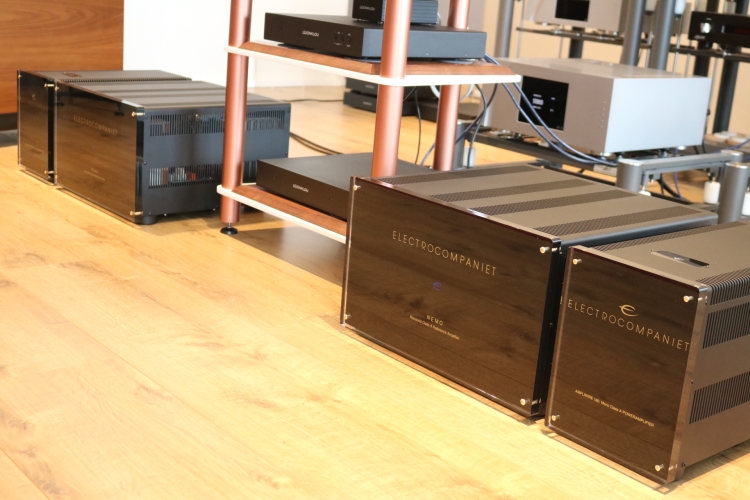
Review samples supplied by Colab
Retail prices in the Benelux (including 21% VAT):
AW600 NEMO 16.598 euro per pair
AW180 8.998 euro per pair
After having reviewed the Zesto system and pondering potential next steps, Pierre and Francois of Colab and Bel Hifi were quick to declare their appreciation for the Norwegian Electrocompaniet brand. If tubes do not apply then this brand is their first choice. Not having any experience with the brand I was absolutely happy to plan for a review. In order to provide the best perspective, I felt that it would be most interesting to review a mid-level model as well as their top-offering.
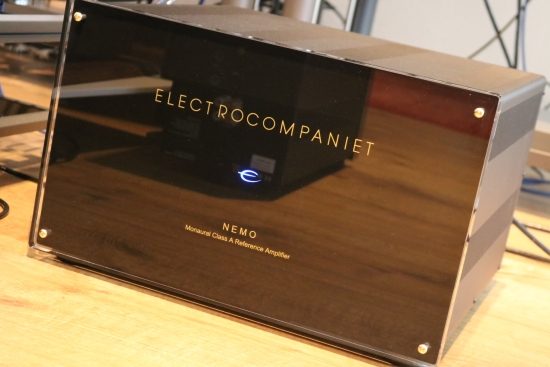
The Electrocomaniet logo glows in different places: on the front for the AW600 Nemo; on the top for the AW180
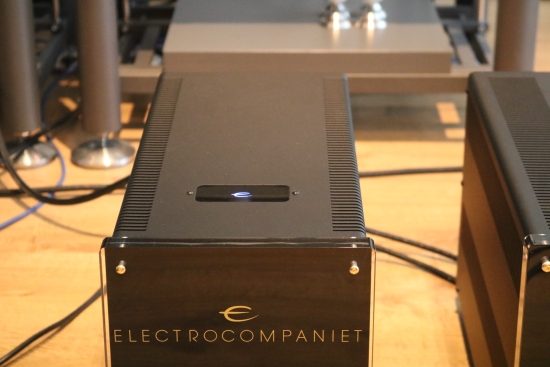
Established in 1973 in Norway, Electrocompaniet is known to voice their equipment to achieve a sound that they feel is most true to the live listening experience first and foremost and according to technical measurements second. Their amplifiers have been used in several Recording Studios, including Michael Jackson’s and Abbey Road Studios. In 2004, the company went bankrupt but the assets were quickly acquired that same year by Norwegian company “West Control”. Under the leadership of a new CEO, Mikal Dregggevik, all production was moved to Tau, near Stavanger. Importantly, the brand remained 100% Norwegian and today they are represented in over 50 countries worldwide.
There’s an interesting story on Wikipedia about how Michael Jackson’s producer Bruce Swedien got hooked on the brand:
In 1991 Michael Jackson’s producer Bruce Swedien was contacted by Nils Bjarne Kvam, a Norwegian producer, whom he told of the amplifiers of Electrocompaniet, and Swedien started getting interested. The amplifiers were packed and shipped to the US in September 1991. Bruce was busy at the time working on the last mix to Jackson’s Dangerous. He loved the amplifiers and wanted to use them on the album, but the mix was almost done, and he would then have to remaster it all over again since the difference was so large. But Swedien was ready to use the amplifiers on the next albums. The next two albums History and Invincible were mastered with the Electrocompaniet amplifiers, and both albums thanked Electrocompaniet with “Special thanks to Electrocompaniet” with a logo on their covers.
It is speculated that the Nemo was specifically designed to work with the B&W Nautilus 801. A Stereophile reviewer found that he required four channels of serious amplification to drive them but, as rumor has it, the output of a single Nemo should be sufficient to drive one full-range 801. Either way, the Nemo name seems appropriately chosen and it is a fact that Nemos are or were used for driving N801’s at Abbey Road Studios in England.
Soundcare super spikes
Both the AW180’s and AW600 Nemos do not have normal rubber or plastic feet, rather, they use the excellent Soundcare super spikes, also from Norway. These smart couplers contain a spike and base, contained within a holding cup which makes it possible to move the amps around (if you are strong enough and don’t have back problems:-) without having to worry about the spikes landing beside the floor bases.
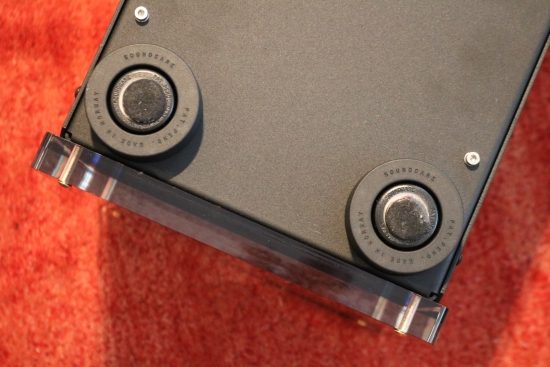
The underside of one AW180 – these super spikes had been fitted with felt pads to allow for easy moving but this is not ideal for the sound.
I used Soundcare super spikes with all the Apogee magnetostatic speakers as they not only proved very handy when moving the big and heavy speakers around but also sounded better than any of the regular spikes that I tried. I’ve not made a separate review but there’s a nice section about them as part of the Apogee Diva review.
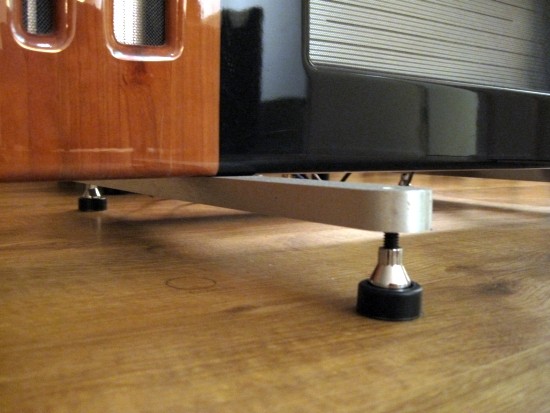
Soundcare super spikes as used in the past with the Apogee Diva loudspeakers
The very strong Jerom, I mean Francois, of Colab/BelHifi handles these amps as if they are lightweights but he also told me that they use Stillpoints as couplers for these amplifiers. Of course, this can lead to even better results but at serious cost.
Class A
With “Class A” written on the front panels, one might be led to assume that these amplifiers actually work in Class A rather than Class A/B. However, these amplifiers are really cool to the touch which doesn’t rhyme with typical Class A behavior. The manuals do not specifically state the working principle so, in order to get clarity, I emailed Electrocompaniet and my mail was promptly responded to by Volker Hunger. As it turns out, Electrocompaniet uses the Class A label similar to how Technics used the Class AA label on their amplifiers in the ’80s. As Volker explained:
“All our amplifiers are Class A/B and have been for approximately 40 years. “Class A”, in this case, is rather meant as a quality designation, like reference… , first-class… High quality… We know, this term can be confusing if someone does not know about the technical details but it has been on our front plates for a long time, so this designation has been kept for historical reasons, just like the acrylic material for our front plates and the golden knobs. All pre- amplifiers and output circuits, for example in CD-players, Steamers, and the like, are a completely class A design. It’s one part of our design philosophy that transistors in these circuits “work on high class A operating points. It is also correct for all circuits of our power amplifiers in up to the output circuit. These are all Class A designs, but of course not the output section”.

System Context
The system used to review these amps consists of the CH Precision C1 DAC, CH Precision A1.5 power amp and the Kroma Audio Carmen and Martin Logan ESL15A electrostatic speakers. The source is the Antipodes CX, straight into the C1 DAC via its Roon-Ready ethernet board. Apart from the aforementioned equipment, some more equipment that was simultaneously over for review was also used, such as the Lejonklou Sagatun dual-mono preamp, as well as three different other speakers. I found that the Electrocompaniets’s sound, as per usual, can be influenced with interlinks and power cables but found that they sound best to my ears using straightforward and open-sounding cables such as Siltech Paris MXT interlinks, Jorma Trinity speaker cables and Belden power cables or, in some cases, the supplied standard power cables. In the case of the latter, any components that the sound was compared to were also outfitted with the same basic cables.
Both the AW180’s and the AW600 Nemos are true balanced designs where the latter are bridged and, in effect, quadruple-balanced. As I have not always had positive experiences with bridged designs, I was curious to find out how the two models compared.
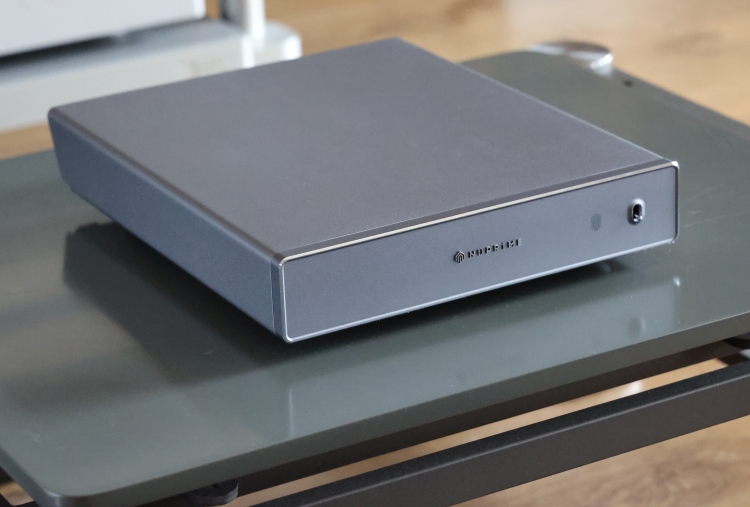
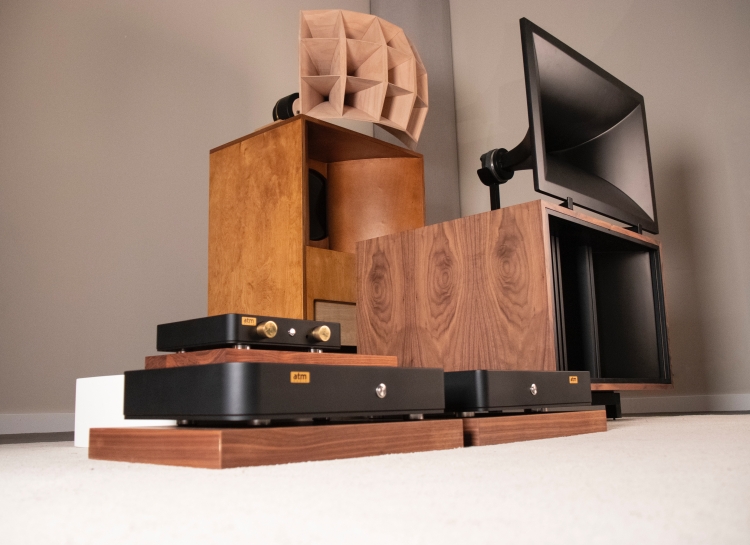
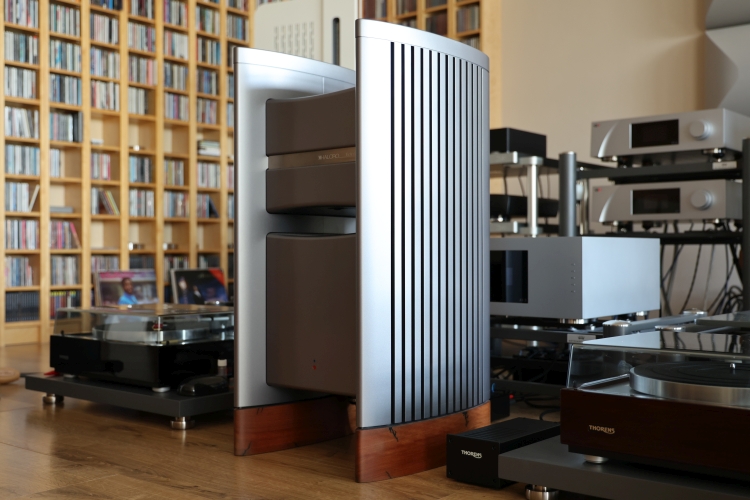
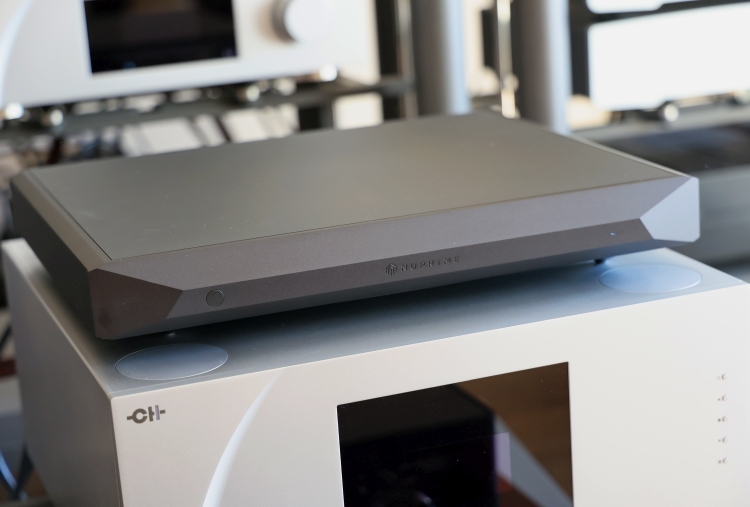
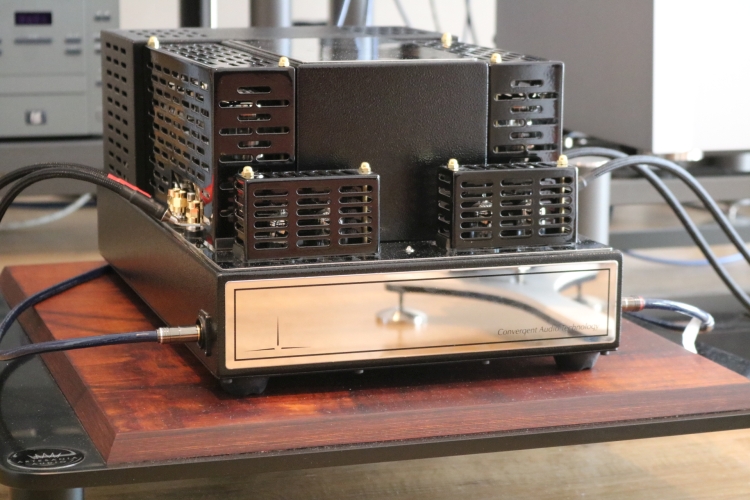
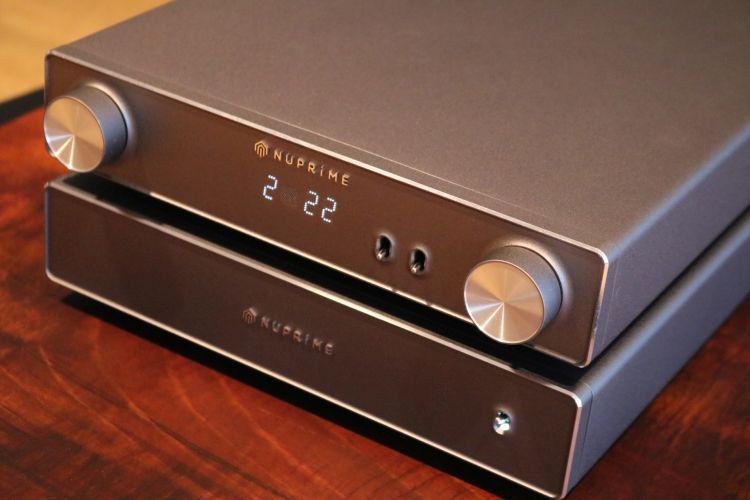
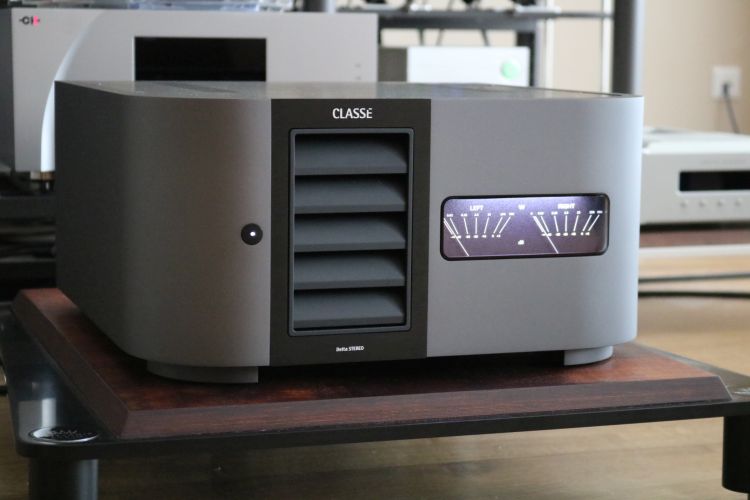
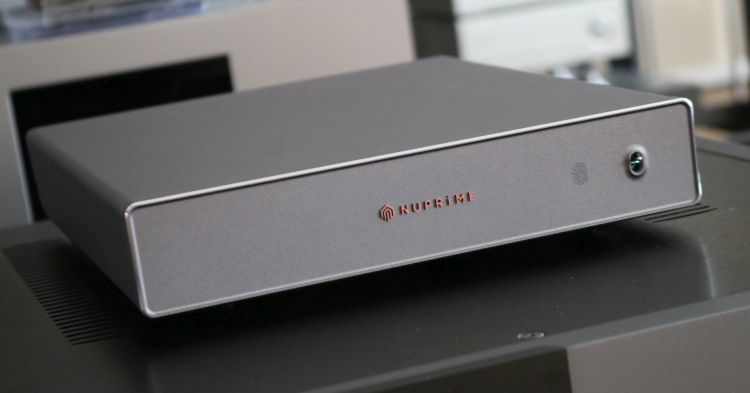
Thank you very much Christiaan for this very well and clear written review. As an AW180 user, with mainly Sonus Faber Guarneri Homage and sometimes ML Summit X, I recognise a lot of your observations. From a technical / historical side it might also be interesting to mention Dr Matti Otala on TIM-free transistor design.
Nice to hear that our experiences seem to match, Bert. I contemplated also getting into the TIM-free principle but the review is already long and it won’t add any value in terms of describing the sound.
I have to say this is a really useful three part review and your insights from the Electrocompaniet, Martin Logan, Depeche Mode combination are most welcome, Christiaan.
Glad to be helpful, Andrew!
Really great review!
Did you manage to listen to the AW400 as well? Would you say they sounds more like AW180 or AW600?
Thanks
Hi Peter, I did ask for the AW400 but it wasn’t available for review, hence the review of the AW180’s and AW600’s. Not having heard the AW400 I can only guess but my best guess is that it will be more similar to the AW180’s than the AW600’s.
Hi, Christiaan & having included the four amps in your review, the two Electrocompaniets and two Bryston ps, if you had to live with one, which one would it be and what would be a close second? A loaded question, I know, but, I am curious, as I have a 4b3 and the opportunity to buy an AW 180.
Thanks,
John
Hi John, it would depend entirely on the speakers that you will pair them with. That matter aside, I really wanted to like the AW180’s for their nice appearance and relatively friendly price but the AW600’s are simply better in all aspects. Since you’re asking what I would do personally given these 4 choices, I would opt for the most neutral amp and the one that works as consistently and with most speakers. That would be the more neutral Bryston 4B SST. However, I should also note that I like the 3B SST even more. It may be a “baby” Bryston but it’s the most even-handed, most neutral and most communicative of the bunch. Finally, all that said, the AW180’s may still be good candidates for you if you want more direct and physical (as opposed to smooth) upper bass and a fuller, more concreted, tonality in the midrange.
Thank you, Christiaan, for your prompt and informative response! I have power hungry Dahlquist DQ10’s that seem to respond quite well to the 4b3 and given the added cost of the 180’s and near astronomical cost of the Nemo’s, perhaps it’s best I remain satisfied!
Again, thank you!
Hello Christiaan,
I am a bit late to the show but read your review with joy. Very comprehensive as well as informative and well written.
I just bought the Nemos from a l0cal dealer and was wondering if they really come with basic 3€ power cords. Mine just like cheap cords for a toaster with no signs that they are made for or by electrocompaniet.
Thanks for letting me know.
Greetings Elderin
Hi Elderin, I can’t recall what power cables were supplied with these amps but having had tons of equipment over for review I can confirm that it is very rare for there to be anything other than a standard no-name brand cable in the box, even with CH Precision et al. At best, there may be a Belden, but even that’s become rare.
I see. Tx for your reply.
Have a good 2021 ?
Sorry, one more question. Hope you can help.
I hear a little bit of hum coming from both mono blocks. It is clearly audible within 3m. Also there is a tiny bit of that also coming from the speakers. In one a bit more than the other.
9am really concernt about that. Is that normal ? My room is pretty small, not what one would normally put such big amps in, about 12qm. So maybe it is normal but I did not hear any noise coming from other amps I owned.
When I put the pre amp on the noise in the speakers is almost completely elimated but the hum from the amps is constant even independent from volume level. It does not get louder or more quiet. I am not shure what the manufacturer would answer. Maybe something like this is within quality control or something so i prefer an honest independ answer. Thank you once again.
Greetings Elderin
Mechanical hum comes from transformers that vibrate according to the mains frequency. This is quite common and can even vary between left and right amps of the same make and model. You should not hear hum from the speakers unless this is induced by unsufficiently shielded cables or other external factors.
Hi Christiaan, I am thinking about one point in your review. You mentioned, the Electrocompaniet amplifiers need quite some volume to shine. Did you detect this finding when connected to DAC only? Did you have the same findings when an analogue preamp was connected? In the past, I made very good experience with the Electrocompaniet ECI 6 (of course different price point). In fact, I did not feel that I had to turn up the volume. Now, I am thinking about the all new Electrocompaniet 800m
Hi Oliver, that review was done with the C1 DAC as a source. Although I later added the L1 preamp, this is not done because the DAC lacked power or drive or any kind of dynamics or presence at low volume. The preamp did add finesse, fluidity, and increased resolution.
Both the Kromas and Logans are very easy to drive. I think maybe the Electrocompaniet amps may also be happier when doing a little more work, ie, driving more demanding speakers. With mine, they were probably basically idling most of the time, until pushed.